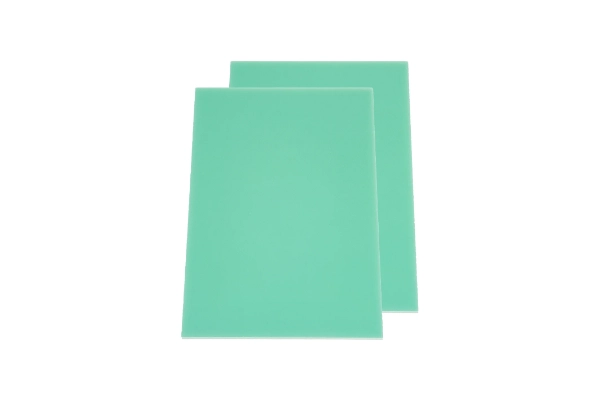- This topic is empty.
-
AuthorPosts
-
24/10/2024 at 18:24 #2205
G10 epoxy glass laminate, a high-pressure fiberglass composite, has become a popular material across various industries due to its exceptional mechanical, thermal, and electrical properties. Comprising layers of woven glass fabric bonded with epoxy resin under high pressure and temperature, G10 exhibits a combination of strength, rigidity, and low weight. While much of its appeal lies in its structural qualities, understanding its environmental properties is equally important, especially for applications in harsh or fluctuating conditions. In this blog post, Blue Sun will share the environmental properties of G10 epoxy glass laminate, including resistance to temperature, humidity, UV radiation, and chemical exposure.
1. Thermal Resistance and Stability
One of the most critical environmental properties of G10 epoxy glass laminate is its thermal resistance. G10 can withstand prolonged exposure to temperatures ranging from -100°C to 140°C (-148°F to 284°F) without significant degradation. It has a low thermal expansion coefficient (about 10-15 ppm/°C), which ensures dimensional stability when subjected to temperature fluctuations.
However, G10's glass transition temperature (Tg) is typically around 120°C to 130°C. Beyond Tg, the material begins to soften, causing a reduction in mechanical stiffness. Thus, for applications where it is consistently exposed to elevated temperatures, it is essential to stay within this thermal envelope to avoid permanent damage.
Additionally, G10 has a relatively low thermal conductivity (0.29 – 0.31 W/m·K), making it an effective insulator. Its thermal performance enables it to operate reliably in environments where other materials might suffer from thermal cycling fatigue or deformation.
2. Moisture Absorption and Humidity Resistance
While G10 epoxy laminates are considered resistant to moisture, they are not entirely immune to water absorption. In highly humid environments, G10 can absorb a small percentage of moisture over time – typically around 0.1-0.3% by weight. The absorption rate may vary depending on the thickness and specific resin content of the laminate.
Moisture uptake can slightly affect the material's electrical insulation properties, though G10 remains superior to many alternatives under similar conditions. For applications such as marine equipment or outdoor electronics, it is advisable to apply surface treatments like varnishing or coatings to reduce moisture ingress. Despite minor changes in dielectric performance with water exposure, G10 retains much of its mechanical integrity even in humid environments.

3. UV Radiation Resistance
Direct exposure to ultraviolet (UV) radiation can cause gradual degradation in epoxy-based laminates, including G10. UV light induces photodegradation of the epoxy resin matrix, leading to surface discoloration, micro-cracking, and a loss of surface gloss. Over extended periods, these changes can compromise the mechanical properties at the surface, though the internal structure of G10 often remains unaffected due to the limited depth of UV penetration.
In outdoor or high-UV environments, protective coatings like UV-blocking varnishes or paints are recommended to extend the lifespan of G10 laminates. While G10 is not specifically formulated for prolonged outdoor exposure without protection, the addition of stabilizing additives during manufacturing can help improve its UV resistance.
4. Chemical and Corrosion Resistance
G10 epoxy glass laminates exhibit excellent chemical resistance to a broad range of substances, including oils, fuels, solvents, and weak acids. However, some limitations exist when exposed to more aggressive chemicals, such as strong alkalis or concentrated acids.
The corrosion resistance of G10 makes it a popular choice in environments where contact with corrosive substances is a concern – such as in chemical processing plants or marine equipment. Its non-corrosive nature allows it to maintain structural integrity in applications where metals would suffer from oxidation or galvanic corrosion. Nevertheless, extended exposure to highly alkaline solutions or concentrated nitric or sulfuric acids may lead to some softening or surface etching of the epoxy matrix.
5. Electrical Insulation Under Environmental Stress
G10 is known for its excellent dielectric strength (around 500-600 V/mil) and low dielectric constant, making it ideal for high-performance electrical insulation applications. These properties are well-maintained under typical environmental stresses, including temperature fluctuations and moderate humidity. However, as noted earlier, water absorption can cause minor, temporary reductions in dielectric properties.
Despite this sensitivity, G10 performs reliably in harsh environments, including aerospace, military, and industrial settings, where electrical insulation must be maintained over a broad temperature and humidity range. Its ability to maintain insulation at high voltages and across varied environmental conditions makes it a material of choice for switchgear, terminal boards, and transformers.
6. Mechanical Durability and Environmental Fatigue
The high mechanical strength of G10 makes it resistant to environmental fatigue. Even when exposed to cyclic loads, vibration, and shock over extended periods, G10 retains its shape and structural integrity. Additionally, it resists creep and stress relaxation, maintaining performance even under mechanical stress. This durability allows G10 to operate reliably in dynamic environments, such as aerospace or automotive applications.
Its performance under environmental fatigue is further enhanced by low moisture absorption and minimal thermal expansion, which prevent dimensional changes and degradation over time. However, in environments with abrasive particles or chemical exposure, regular maintenance and surface inspections are recommended to mitigate surface wear.

Conclusion
G10 epoxy glass laminate is a high-performance material with robust environmental properties, making it suitable for a wide range of industrial and technical applications. Its ability to withstand thermal and mechanical stress, resist moisture and chemicals, and maintain electrical insulation in demanding environments makes it indispensable in fields such as aerospace, electronics, and marine engineering.
https://www.bluesun-elec.com.cn/Environmental-Properties-of-G10-Epoxy-Glass-Laminate.html
http://www.bluesun-elec.com.cn
Blue Sun -
AuthorPosts
- You must be logged in to reply to this topic.